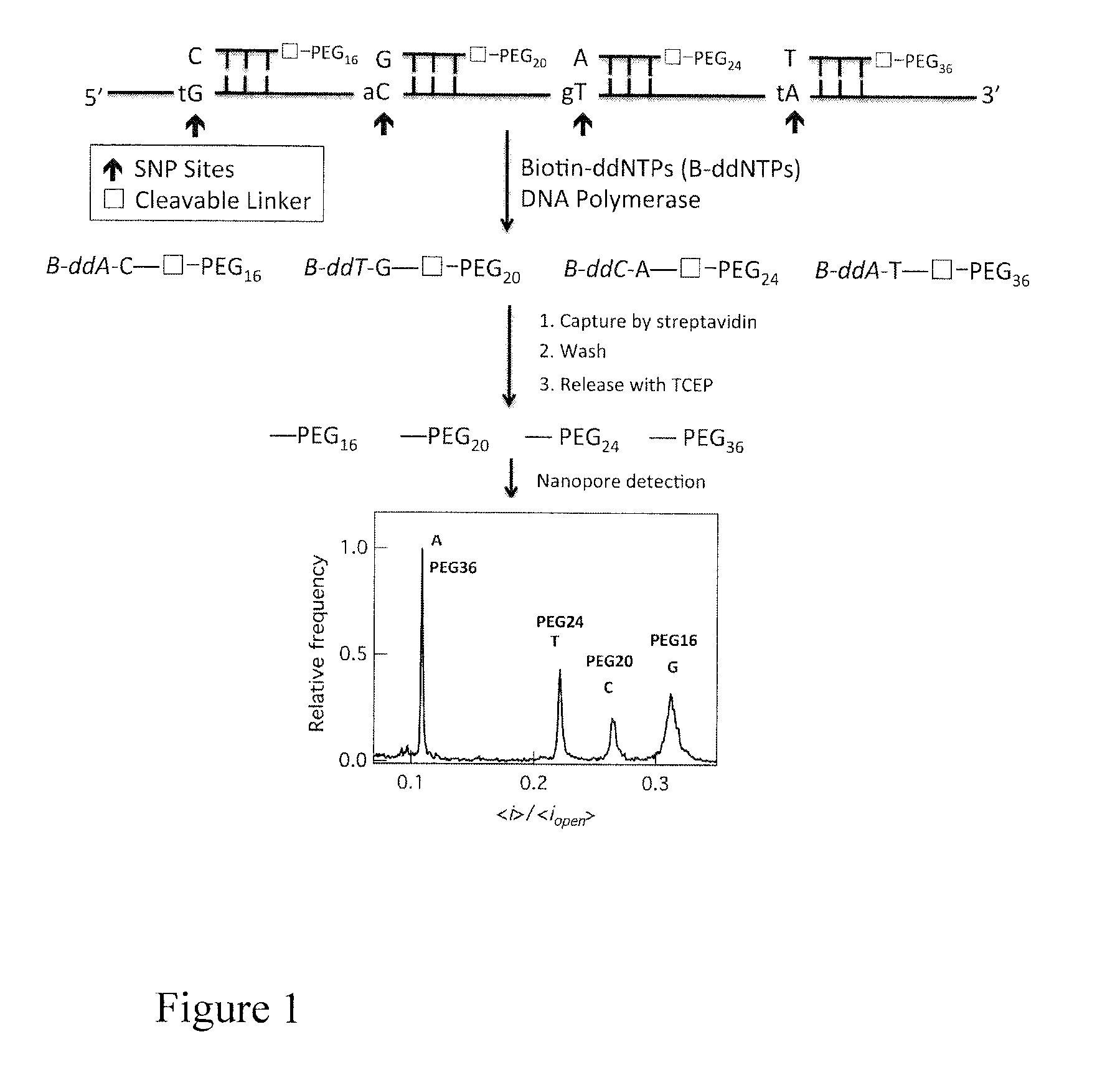Single molecule electronic multiplex SNP assay and PCR analysis
a single molecule, electronic multiplex technology, applied in the direction of microorganism testing/measurement, biochemistry apparatus and processes, etc., can solve the problems of many enzymatic reaction steps, complicated probe design, and inability to precisely detect snps
- Summary
- Abstract
- Description
- Claims
- Application Information
AI Technical Summary
Benefits of technology
Problems solved by technology
Method used
Image
Examples
experiment 1
Synthesis of Primers Coupled with Cleavable Coumarin-(PEG)n Analogs
[0154]All of the PEG analogs were purified by reverse-phase HPLC on a 250×10 mm column (Supelco), using the following mobile phases: A, 8.6 mM Et3N / 100 mM 1,1,1,3,3,3,3-hexafluoro-2-propanol in water (pH 8.1) and B, methanol; or A, 0.1M triethylammonium acetate (pH 7.5) buffer and B, acetonitrile gradient. The mass spectra for the corresponding molecules were obtained on a MALDI-TOF MS spectrometer (Voyager-DE BioSpectrometry Workstation, PerSeptiveBiosystems). All steps of the synthetic scheme are shown in FIG. 3, and are identified below with the numbers used to label them in FIG. 3.
[0155](A) Synthesis of Coumarin-PEG-Acids and NHS Esters
[0156]The commercially available Amino-PEG-acids (Amino-dPEG16, 20, 21, 36-acids) (2-5) were first reacted with 6-methoxy coumarin-NHS ester (1) to produce the corresponding coumarin-(PEG)n-acid (6-9). Thus, to amino-(PEG)n-acid (2-5, 1 eq) dissolved in carbonate-bicarbonate buffer...
experiment 2
Characterization of the Cleavable PEG-Labeled Primers and their SBE Cleavage Products
[0161]FIG. 4 outlines the molecular mechanism of the SM-EMS assay with PEG-primers and biotin-ddNTPs. The DNA template containing polymorphic sites is incubated with a library of PEG-primers, Biotin-ddNTPs and DNA polymerase. The nucleotide at the 3′-end of each PEG-labeled primer is complementary to a particular SNP in the DNA template. Only the perfectly complementary PEG-labeled primer is extended by DNA polymerase with a Biotin-ddNTP. The streptavidin-coated magnetic beads only capture the biotinylated DNA extension products while the other components are washed away. Treatment of the captured DNA products with TCEP cleaves the PEGs, which will be analyzed by nanopore for their unique electrical current blockade signatures, each of which determines a unique SNP.
[0162]Three PEG-primers were characterized by MALDI-TOF MS and the results are shown in FIG. 5. Each PEG-primer produces a single peak i...
experiment 3
Identifying Gene Targets Via Primers Having MassTags Attached
[0172]PCR using custom MassCode primers (primers with MassTags attached) has been used to identify gene targets (Briese et al. 2005 and Palacios et al. 2006). A library of primers is prepared, each with a unique MassTag attached via a cleavable linker. PCR amplification is performed on the target gene, so that the two primers complementary to each strand of the target gene are incorporated to the PCR products. The PCR products undergo a purification step, so as to remove the unreacted excess primers. These PCR products are then eluted into a multi-well plate for mass spectrometry analysis. The two mass tags are cleaved and analyzed with a mass spectrometer, identifying the two cognate tags, therefore identifying the primers from the library to which they were originally attached. This information is used to identify the target gene. This process requires the use of bulky and expensive mass spectrometry equipment, however (...
PUM
| Property | Measurement | Unit |
|---|---|---|
| Fraction | aaaaa | aaaaa |
| Fraction | aaaaa | aaaaa |
| Fraction | aaaaa | aaaaa |
Abstract
Description
Claims
Application Information
 Login to View More
Login to View More - R&D
- Intellectual Property
- Life Sciences
- Materials
- Tech Scout
- Unparalleled Data Quality
- Higher Quality Content
- 60% Fewer Hallucinations
Browse by: Latest US Patents, China's latest patents, Technical Efficacy Thesaurus, Application Domain, Technology Topic, Popular Technical Reports.
© 2025 PatSnap. All rights reserved.Legal|Privacy policy|Modern Slavery Act Transparency Statement|Sitemap|About US| Contact US: help@patsnap.com



